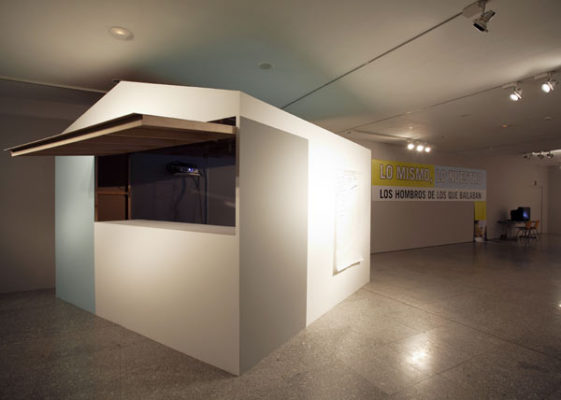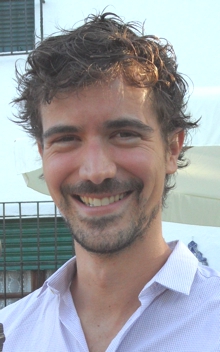Search
To search for an exact match, type the word or phrase you want in quotation marks.
A*DESK has been offering since 2002 contents about criticism and contemporary art. A*DESK has become consolidated thanks to all those who have believed in the project, all those who have followed us, debating, participating and collaborating. Many people have collaborated with A*DESK, and continue to do so. Their efforts, knowledge and belief in the project are what make it grow internationally. At A*DESK we have also generated work for over one hundred professionals in culture, from small collaborations with reviews and classes, to more prolonged and intense collaborations.
At A*DESK we believe in the need for free and universal access to culture and knowledge. We want to carry on being independent, remaining open to more ideas and opinions. If you believe in A*DESK, we need your backing to be able to continue. You can now participate in the project by supporting it. You can choose how much you want to contribute to the project.
You can decide how much you want to bring to the project.

The patron saint festivities that are repeated every summer in villages and cities can seem a bizarre subject for contemporary art. A drunken crowd that continues with fervour the traditions of a territory is perhaps far from the critical and autonomous public that the artistic sector seeks. Seen as too trivial, or even, as reactionary, the phenomena of these festivities doesn’t seem to be dignified enough to pass through the doors of the museum. It is to her credit that Itziar Barrio (Bilbao, 1976) has known how to show the error of this vague prejudice.
Until the beginning of September one could visit at Artium an installation by Itziar Barrio called “Detrás, al final de la comparsa (At the back, behind the parade)”. The exhibition, curated by Blanca de la Torre, was within the framework of the Praxis programme that emphasises the procedural nature of the artistic process through the (praiseworthy) mechanism of opening the exhibitions to the public from their very inception. So during the months of June, July and August visitors to Artium have had the opportunity to watch the progress of the changing installation by Itziar Barrio. A structure dominated the exhibition space from the very beginning, seeming to emerge from one of its walls. It is a txosna, the traditional bar-stand in the form of a little shack that forms the centre of all street festivities in the Basque Country, usually run by a specific collective (or cuadrilla). Inside the structure there were the projections of videos that the artist had filmed during several popular festivities in Vitoria-Gasteiz: in the districts of Errekaleor and Judizmendi, in July, and those of La Blanca, that the whole city celebrates at the beginning of August. During the process “workshops by false cuadrillas” were held in which the participants had to invent the symbol of a collective. The result: seven images take the form of particular signs or icons for the fiesta. The final content of the space is completed with two other interventions: a banner that is a variation of the characteristic posters of the txosnas and a dark corner that refers to the inevitable corner in all festivities, the secret hideout for forbidden pleasures.
This complex and multidisciplinary process with which Itziar Barrio brings the popular parade to the museum would be irredeemably marred if the artist didn’t know how to resist the temptation to adopt one of the two following positions: to contemplate the fiesta “from above” or “from the inside”. She would have fallen into the first if she had opted for the strategy of the replica when exhibiting the characteristic elements of the fiesta. The central structure can be recognised by the public particularly because it displays the essential form of a txosna, but it doesn’t pretend to be a copy of the real txosna, it is more like its common denominator, its abstraction. The artist in this way averts the temptation to elaborate a faithful replica of the original, a gesture that would have come close to the mechanisms used by the old natural science and ethnography museums, where diverse human (“primitive”) habitats were shown to the spectator, frozen thanks to the arts of taxidermy. The conversion of a horizon of events and social expectations into a picturesque scene, presupposes its brutal subordination to a discourse that pretends to explain them from a position of veiled superiority. This is not, thankfully, what we are presented with.
Itziar Barrio also avoids the other temptation that, in fear of being contaminated by an imposed sterility, becomes immersed in the object, bringing it to life from within. In the case of the fiesta it would involve the staging of a festive ecstasy, forgetting that the artist alone can’t reproduce the historic and communal conditions that cause it. The pathway towards this pretended immediacy leads us to spectacles that are more or less grotesque (think of Viennese Actionism), that have nothing in common with the authentic fiesta, where the figure of the audience doesn’t exist.
Eluding these two temptations Itziar Barrio maintains the difficult balance between the documentary (that the descriptive desire of the first brings) and the theatrical (that shares the appropriating aims of the second) incorporating elements of both and presenting them in a fertile contradiction from a position that is external, yes, but one that is also situated at the same level as those who are celebrating; to be precise: “behind, at the end”. The position that the artist chooses when approaching the subject, explicit in the actual title of the exhibition, is marginal, that is to say it is situated at the edge of the fiesta, at its limit or, to be more precise the reverse of what one actually sees, from behind. Itziar Barrio insists on permitting the voice of the festive group that marches in front of her, limiting herself to indicating indirectly their ins and outs, behind the scenes, that forms in its dissimulated condition a social construct. In effect the fiesta always reclaims for itself the aura of the immemorial and presents itself as the inevitable expression of a populace. These naturalising pretensions left unsaid as the fiesta unrolls, form a process of collective construction of meanings. With this aim the artist uses particularly fortuitously the rubric of the exhibition in the Praxis programme, which, as we have said, allows the public to observe the gradual process of the montage in the space: it is the form of the installation itself, even before its content, which indicates the procedural (not incidental) and constructive (not natural) character of all meaning. As such the artistic proposal and the object acquire a relation of isomorphism.
The marginal position chosen by the artist can be, to a large extent, the inevitable product of the circumstances: Itziar Barrio, born in Bilbao, is dealing with popular festivals that aren’t the ones with which she has grown up; they are not her own, one feels tempted to write. But it is just at the moment of writing this possessive, (“her fiestas”) that the trivial anecdote is elevated to a significant strategy. By documenting some fiestas that are not “hers”, in situating herself “behind” the parade, Itziar Barrio indicates a phenomenon that is essential in the fiesta, understood – in its traditional function – as a process of construction of identity. In order for a renewed “us” to arise from the very centre of the ecstasy of the festival, the invocation of a “them”, that is constructed in a negative way is needed: of those that are not from “here”, those who don’t really know how to dance, to dress or how to drink. The ghostly “them”, that is convoked as a perverse but impotent spirit around the festive community, is indispensable for the renewal of the group identity. Them and us are the two faces of the same story.
This is the inseparable duality to which the enigmatic slogan of the banner alludes in the Artium space, beside the txosna. In it one can read “The same, ours” and below, “The shoulders of those who were dancing”. To understand fully why the first expression synthesises skilfully the festive experience of the participants one must remember the ritual nature of the fiesta. Like any ritual, the fiesta (and we are referring always to popular patron saint festivities and their like) consists in the periodic re-enactment of an event of a mythical character, in which one recognises a community. The fiesta is repeated every year “the same”, namely: “ours” and the specific content of the supposed original event is obviously not important. Many Vitorians are unaware that the fiestas of La Blanca celebrate the fact that the Esquilino hill in Rome appeared on the 5 August in the 5th century, covered in snow. However, established events that are repeated year after year are enough in themselves to commemorate “something” that acts as the communal link. If we are to believe René Girard, this “something” is always a crime. Even the myth in many ways endeavours to camouflage that the origin of every community consists in the lynching of an innocent victim, marked with the signs of the “other” that was later praised as a deity or a founding hero. The origin of the fiesta, and the community that celebrates it, is in this sense awash with blood and injustice.
The fiesta conserves a remnant of ritual violence in the implicit exclusion that is always exercised. Those who don’t belong to the festive community can only see “the shoulders of those who dance”. This expression of the banner is taken from chapter 15 of The Sun Also Rises, in which Hemingway narrates the explosion with the chupinazo of the San Fermin festival, and writes: “The dancers were in a crowd, so you did not see the intricate play of the feet. All you saw was the heads and shoulders going up and down, up and down.”. The quote totally encapsulates the monstrosity, the chaos, the informality of the experience of those who celebrate, who appear to agglutinate into one single body. The collapse of ordinary social relations that regulate and sustain individuality (temporarily) dispels the obligation to sublimate and control one’s impulses. As the dark corner Itziar Barrio placed in the Artium space reminds us, the single body of the festive community is no longer subject to scatological, sexual or violent taboos. This liberty is transitory, and it would be innocent to interpret it as a form of emancipation. Its role, in the end, is to reinforce the very norms that it breaks, that are reinstated as soon as the fiesta ends. The exultant transgressing body becomes the ordered community and the dark underbelly of exclusion and violence concealed behind the facade of its symbols is soon forgotten. Nothing is more vital than to remember that.

"A desk is a dangerous place from which to watch the world" (John Le Carré)